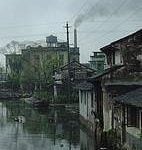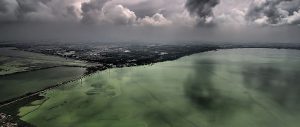In early February, the results of a national pollution survey released by the Chinese Ministry of Environmental Protection (MEP) showed that the country’s pollution problems were much worse than previously estimated. The international media appeared to accept the ministry’s explanation for the discrepancy in its figures – agricultural sources of pollution had not previously been included. But such reports overlooked a more crucial factor: over the last two years the MEP has made no real headway in tackling pollution. It has merely made some feints and declared a paper victory.
On November 2 last year, Chinese news agency Xinhua reported that the minister for environmental protection, Zhou Shengxian, had claimed that China had “stopped water pollution worsening” and seen slight improvements in all areas over the previous year, during a speech at the 13th World Lake Conference, held in the central Chinese city of Wuhan.
This conclusion does not match the facts. On November 11, the People’s Daily reported that, in spite of a six year investment programme, which saw 91 billion yuan (US$13.3 billion) spent on efforts to improve China’s three most polluted rivers and lakes, water quality remains poor. As the development of the Yangtze Delta has charged ahead, for example, the standard of water in Lake Taihu, eastern China, has fallen by three grades – from grade two in the 1980s to grade five or worse now. The many textile-dying, chemical- and food-processing plants around the lake have caused a major accumulation of pollutants. Lake Chao, in eastern China, and Lake Dian, in the south-west, have both shrunk and become more polluted as a result of aquaculture, reclamation of land for agriculture and the building of factories.
The MEP is also aware that, over the past year, there have been 12 incidents of heavy metal and metalloid pollution in Fengxiang in central China, Wugang in south China and Dongchuan, a district of the south-western city of Kunming. These cases left 4,035 people with excessive levels of lead in their blood and 182 with excessive levels of cadmium and gave rise to 32 “mass incidents”, or public protests.
The MEP’s national pollution survey itself undermines the department’s official statements. And even without that data, the Chinese public can see, smell and taste that water quality is still falling and that the environment as a whole is worsening. So why does the ministry insist that water quality is improving? Vice-minister of environmental protection, Zhang Lijun, explains that levels of sulphur dioxide and Chemical Oxygen Demand (COD) – a measure that helps determine the amount of organic pollutants in surface water – both fell in 2008 and 2009. This is the basis for the MEP’s claim.
But there are many different indicators of water quality. Measuring just two of these is clearly inadequate and can lead to the wrong conclusions being drawn – as the MEP has shown. It is as if the ministry is a doctor who has declared a patient suffering from a brain tumour healthy on grounds of normal blood pressure.
As the highest of China’s environmental protection agencies, the MEP must be aware that it is impossible to get a full picture of water quality by measuring just two factors. Nor can it be ignorant of the reality of China’s deteriorating rivers and lakes – given the national pollution survey has been underway for two years, the ministry must be familiar with the actual situation. But three months before the survey results were released, it was still saying that China had “stopped water pollution worsening”.
Why would the MEP do this? A quick look at its record over the past two years provides an answer: it was in dire need of an achievement.
Two years ago, the State Environmental Protection Agency (SEPA) was upgraded to ministry status and its powers expanded. But the department’s actions since then have been disappointing. As a mere agency, SEPA may have been weak, but it still managed to cause a stir. It launched crackdown after crackdown – known as “environmental storms” – against companies that broke regulations, including the largest of hydropower firms. It enforced regional planning restrictions, refusing to approve projects for law-breaking local governments until changes were made. It called a halt to illegal works at Beijing’s Old Summer Palace and held an unprecedented public hearing, which became a model for public participation and democratic decision-making.
New legal documents, the “Temporary Measures for Public Participation in Environmental Impact Assessments” and “Regulations on Publication of Environmental Information”, were drafted to ensure the public’s right to environmental information and participation. Research on environmental planning law was conducted and the concept of Green GDP explored as a way of tackling China’s worship of unbridled growth – which lies at the heart of China’s environmental deterioration.
All of these were significant victories, achieved by a weak government agency fighting real battles against powerful interest groups and building systems for better long-term governance. In 2007, I wrote that SEPA was little more than an unarmed weakling, yet it had already fought long and hard for the environment. Its bravery was recognised – but its weakness was also clear. It was not an independent ministry under the State Council, China’s highest administrative body, and it struggled to participate in policymaking and to coordinate with other departments. It lacked executive powers and capacity. So I and many others said: “If we expect this organisation to deal with the huge issues it faces, we must change the systems and legislation that surround it, and grant them increased power.”
Two years ago, the agency finally became a ministry and won greater powers. It was no longer a dwarf, but a full-grown man. But, disappointingly, it has achieved little of note since then. New regulations on public participation in environmental impact assessments and the publication of environmental information have been implemented, but this work started before ministry status was awarded and work was only needed on the final stages. And new laws governing environmental evaluations have so far failed to resolve any issues of public concern over major construction projects.
Moreover, the “environmental storms” have stopped blowing, with the exception of last year’s decision to halt two illegal hydropower projects on the Jinsha River, south-west China. Even then, the MEP only rushed to put a stop to them after State Council leaders started to take a look at the issue of illegal projects in the area. Prior to that, the ministry had quietly approved a different dam. True, sulphur dioxide and COD levels have fallen somewhat. But how much was this the result of reduced industrial production during the economic crisis? Moreover, “green GDP” was left by the wayside, after repeated cries of “not ready yet”.
After all this, the MEP needed a success to show to its superiors and the nation. So “worsening water pollution” was – on paper – stopped. To be fair, the national pollution survey is a big step forward. It has provided relatively accurate data and proved that the ministry’s own “achievements” are not all they may seem.
A few days ago an American reporter asked me whether or not China was really committed to environmentally friendly development. Like her, many foreigners are confused. The idea of building an “ecological civilisation” was included in the report of the 17th Party Congress and China’s leaders are calling for the development of a low-carbon economy and emissions-reduction measures to combat climate change. These are all solemn undertakings. But environmental damage continues to worsen, and not only do the environmental authorities do nothing – they claim false victories.
This does not look like environmentally friendly development. I could not answer the reporter’s question, just like I cannot explain the ministry’s failings over the last two years. If I had to reply, I could only say that I believe that China’s leaders have made the decision to go down a green path, but local government and environmental authorities have not yet taken this seriously.
Liu Jianqiang is editor in chinadialogue’s Beijing office.
Homepage photo of Taihu Lake by Greenpeace



